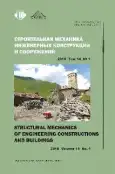STRESS-STRAIN STATE OF THE RECTANGULAR PLATES ON THE BASIS OF REFINED THEORY
- Авторлар: TRAN N.D.1, FIRSANOV V.V2
-
Мекемелер:
- Le Quy Don Technical University in Hanoi, Vietnam
- Moscow Aviation Institute (National Research University), Moscow, Russian Federation
- Шығарылым: Том 14, № 1 (2018)
- Беттер: 23-32
- Бөлім: Theory of elasticity
- URL: https://journal-vniispk.ru/1815-5235/article/view/346355
- DOI: https://doi.org/10.22363/1815-5235-2018-14-1-23-32
- ID: 346355
Дәйексөз келтіру
Толық мәтін
Аннотация
Two variants of a refined theory for calculation of the rectangular orthotropic plates stress-strain state are represented. The plate's state equations are presented in the form three-dimensional equations of elasticity theory. The components of the plate's stress-strain state are received as the polynomial func- tions on the coordinate which is normal to the middle plane. These functions are one or two degree higher than in the Kirchhoff-Love theory are used. The virtual displacements principle is applied to obtain the two-dimensional equations and its natural boundary conditions. The modified boundary conditions for standard cases of the plate mounting are formulated. Calculation of plate stress-strain is carried out by using Laplace transform, and then the number of arbitrary constants in the integration of differential equations systems thus is twice reduced. One of the refined theory distinctive features consist in direct integration of the three dimensional elasticity problems equilibrium equations at transverse normal and tangential stresses determination. As an example, the paper considers the calculation of a rectangular isotropic plate's stress-strain under a local load. The results obtained by the refined theories and by the classical theory are compared. The essential contribution of normal transverse stress of type "boundary layer" to the general stress- strain state of a plate is shown. The received results can be used in calculations and at tests for strength and durability of aviation and space-rocket and also engineering structures of different destination
Авторлар туралы
NGOC TRAN
Le Quy Don Technical University in Hanoi, Vietnam
Хат алмасуға жауапты Автор.
Email: ngocdoanmai@gmail.com
Phd, Head of the department "System Design of Aircraft" of Le Quy Don Technical University in Hanoi, Vietnam. Scientific interests: dynamics and strength of composite structures, aeroelasticity of aircraft, development of definite the stress-strain state calculation methods of plates and shells
Вьетнам, 236 Hoang Quoc Viet, Hanoi, VietnamVALERY FIRSANOV
Moscow Aviation Institute (National Research University), Moscow, Russian Federation
Email: kaf906@mai.ru
Doctor of Engineering Sciences, Professor, head of the Department Theory of machines and machine components of the Moscow Aviation Institute (National Research University). Scientific interests: development of orthotropic plates and shells with a constant and variable thickness non-classical theory on the basis of more exact solution of three-dimensional elasticity theory equations variation-asymptotic method.
4 Volokolamskoe shosse, Moscow, 125993, Russian FederationӘдебиет тізімі
- Picul, V.V. (2000). The modern condition of theory shells and the perspectives their progress, Izvestiya RAN, Mechanic of Solids, (2), 153–168. (In Russ.).
- Goldenveizer, A.L. (1976). Theory of Elastic Thin Shells. Moscow: Nauka publ. 512. (In Russ.).
- Firsanov, V.V. (2002). Refined theory of rectangular composite plates. Mechanics of Composite Materials and Structures, 8 (1), 28–64. (In Russ.).
- Firsanov, V.V. (2016). Stress state called as "boundary layer" is boundary torsion of the rectan-gular plate. Structural Mechanics of Engineering Constructions and Buildings, (6), 44–51. (In Russ.).
- Zveriaev, E.M. (2016). Constructive Theory of Thin Elastic Shells. doi: 10.20948/prepr-2016-33. URL: http://www.keldysh.ru/papers/2016/prep2016_33.pdf (In Russ.).
- Vasiliev, V.V., Lurye, S.A. (1990). Problem of developing nonclassical theory of plates. MTT Mechanics of Solid, (2), 158–167. (In Russ.).
- Firsanov, V.V., Tran, N.D., (2011). Energy-Consistent theory of cylindrical shells. Journal of Machinery Manufacture and Reliability, 40 (6), 543–548. (In Russ.).
- Dicarlo, A., Podio-Guidugli, P., Williams, W.O. (2001). Shells with thickness distension. Intern. J. of Solids and Structures, 38 (6-7), 1201–1225.
- Jaiani, G. (2015). Differential hierarchical models for elastic prismatic shells with microtem-peratures. ZAMM (Journal of Mathematics and Mechanics), 95 (1), 77–90.
Қосымша файлдар









